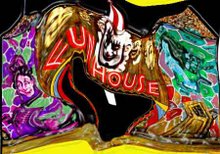The Stift Melk
We had the opportunity to tour the monastery and took a tour, went to mass in the church and visited the museum and the library. In many of these places photos are not permitted, so I have compiled a bunch of photos from the internet. Wikipedia has many such photos in their commons- and since taking pictures was not allowed any other photos are most likely photos tht somebody took illegally. Some images are from the website of the monastery itself. (I'm covering Melk before our trip to Vienna).
We celebrated mass in the church and had ample opportunity to contemplate the churches' beauty while listening to a very inspiring sermon about being open to and tolerant to the new people entering Austria.
When you enter the church all the barock decor can be a bit overwhelming. As you sit and listen, you start to pick out details of things, like the sensuous wood of these misericordia.
or the carving on these pews.
In 1783 the church again experienced change from what was known as Josephism. The emperor Jospeh II called all the priests to be brought to Vienna and trained in the ideas of the time: including enlightened absolutism.
Here (abovve) are the pipes of the organ.
This (above) is the departure of Peter and Paul.
Below is the alter of St. John
Here is an absolutely beautiful pulpit.
Below you can see a reliquary with a saint enclosed in a case.
And here is the altar in all of its magnificence. (Or as close as you can get in a photograph.)
One must not forget to look up either.
The ceilings are beautifully painted in proper Barock-style.
The cupola is also gorgeously decorated. (Of course).
If you cannot leave that church a better person than you went in, then there is something very wrong with you.
The museum is quite informative and again one cannot take pictures, but I found this one on line. What I love about the museum is the mirrored walls that allow the Barock items to seem like they are amongst dozens of similar Barock items. It makes the space seem barock even though it is a plain room.
This is the entry which details the founding of the monastery. The rolling floor, I think, represents the ups and downs of the monastery's history.
The tour of the abbey took us through a variety of rooms. I like this hallway because there is a remnant of the romanesk structures here with the barrel vaulting and rounded arches.
Hereis th famous marble hall.
The mural from 1731 shows Pallas Athena (the Greek goddess of wisdom ) and Hercules (showing his might) in an allegroical reference to the Emperor Charles VI.
Here is a better shot from Wiki commons by Alberto Fernandez Fernandez.
Outside the hall is a wonderful panoramic view of the area.
What impressed me the most of course, was the library.
Again we were not allowed to take pictures, so these are from Wiki, but it just felt so "enlightened" inside being surrounded by all the knowledge of the 1700s!
There was also this cool clock from the 1800s
It is called the Bad Ischel clock and was built around 1801, I think.
There was more than one library room, with one feeling more dark and masculine and the other feeling more gilt and rococco.
Pictures are certainbly not a good substitute for the experience itself, but at least these can help us remember a bit of what we saw!

































No comments:
Post a Comment